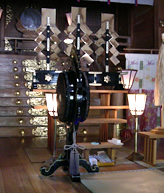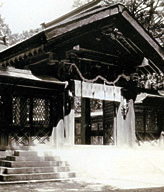![]()


![]()
In the era of Jimmu (the 1st Emperor), a grandson of Ame-no-Futodama-no-Mikoto, Ame-no-Tomi-no-Mikoto embraced the command of the god, and came down to Awa (former name of Tokushima), seeking fertilized land to sow hemp seeds. The people propagated it so that they could produce linen called "asa", which formed the base of the productive industry. Since he had proceeded the advantage and the welfare of the nation, they dedicated a shrine here to the god to be worshiped as the protecting deity, named Oasahiko-no-Okami.
Tradition of Sarutahiko-no-Okami is that he had been dedicated to the peak of Mt. Oasa before he took active roles all across the country. (The god is mainly known as the guide of the ancestor of the emperors of Japan, Ninigi-no-Mikoto from Heaven.) After his various archievements he was enshrined here together with Oasahiko-no-Okami.
Under the ancient governmental system of Engi (around 800 A.D.) Oasahiko Shrine was listened as one of the most highly respectable shrines to the prayers, called Myojin Taisha. Having been praised as Awa-no-kuni Ichi-no-miya (the most respectable shrine in Tokushima), and worshiped as the god of the total area of both Awa (Tokushima Pref.) and Awaji (the largest island of Hyogo Pref.)
In the First year of Seiwa Emperor's era (866 A.D.) the shrine was awarded the upper 5th grade. Then it had been graded up and up till was awarded the 1st grade in the 4th of Nakamikado Emperor's (1719 A.D.). So highly worshiped by the Imperial Court, the loads and so on,it was contributed fields, a mountain with the forest,and also the shrine fascilities were rebuilt with in the fund from the prefectural government budget. It has been given a contribution for the big ceremony from the court (nowadays from Jinja Honcho, the headquarters of the Association of Shinto Shrines) for more than 1000 years.
In 1873, it was listed as a Kokuhei Chusha (the national middle shrine to be worshiped highly by the country), and so all the facilities were rubuilt or added by the country in 1890. Later on the present Main Sanctuary, Hall of Worship, Outer Hall of Worship came to be rebuilt with the donation from the worshipers.
